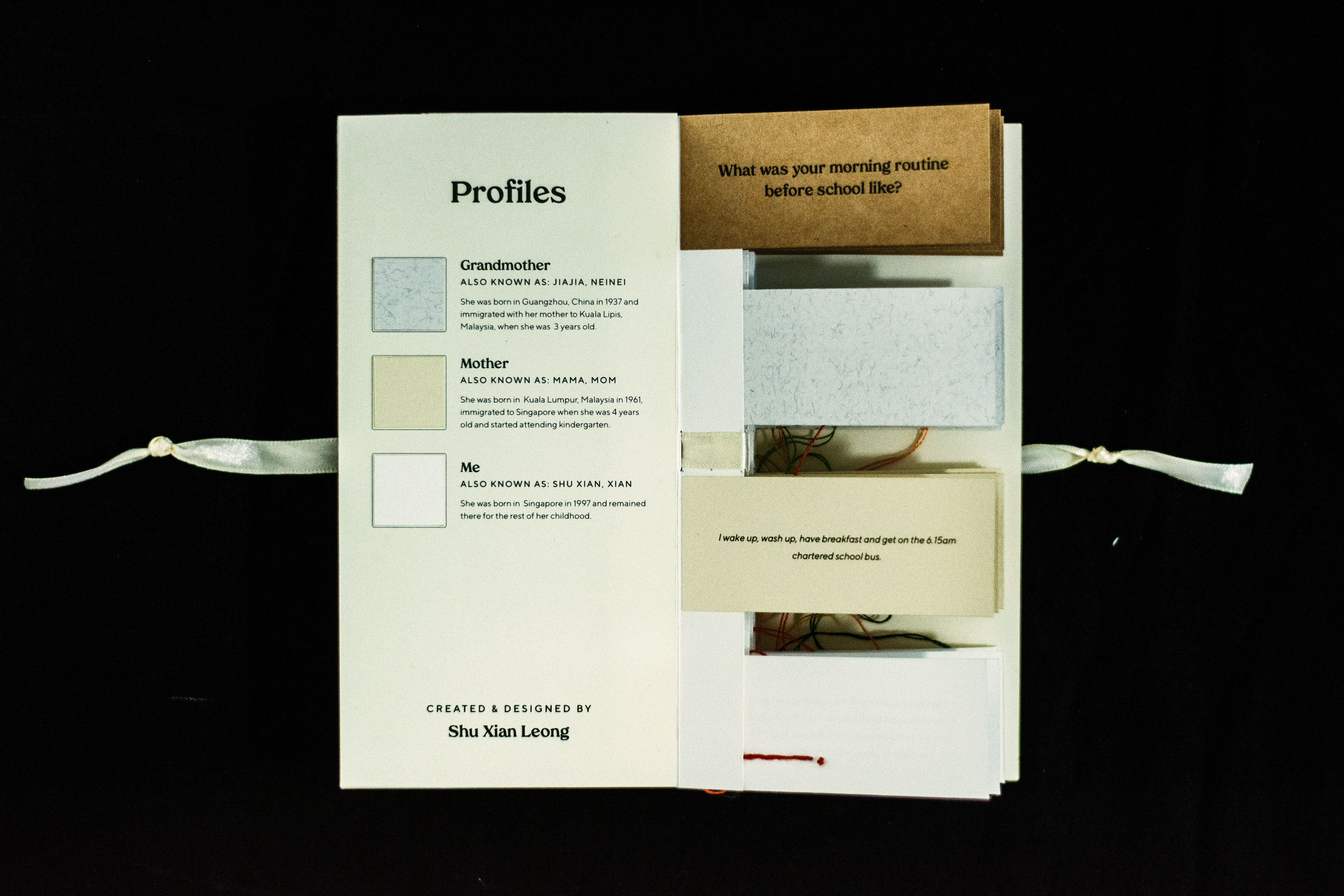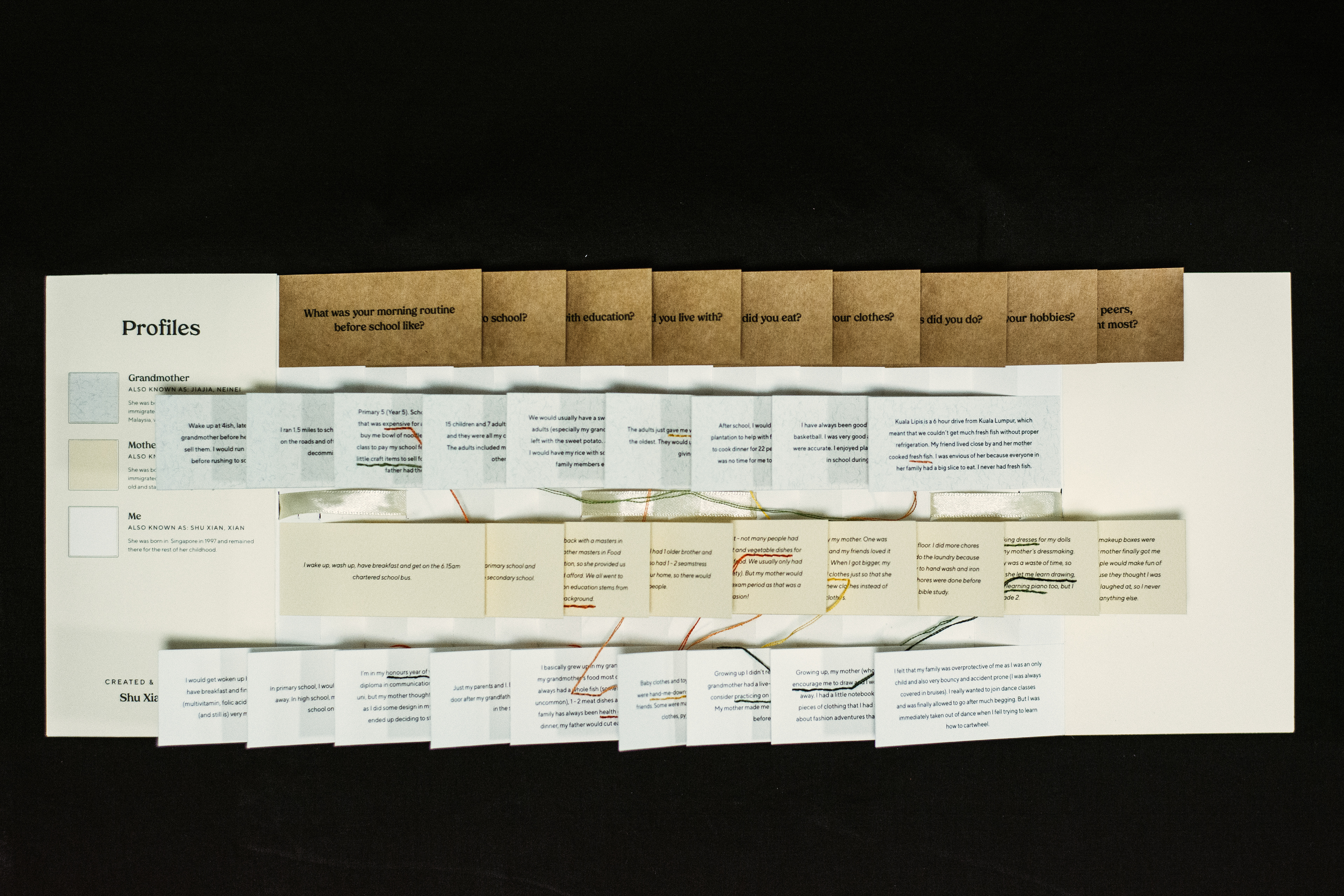Project Context
Halbwachs, M. (1992). The collective memory of the family. On collective memory (L. Coser, Trans.). University of Chicago Press.(Original work published 1925)
Halbwachs, M. (1992). The collective memory of the family. On collective memory (L. Coser, Trans.). University of Chicago Press.(Original work published 1925)
This is a chapter from French sociologist Maurice Halbwachs' book on his theory of collective memory. As a whole, Halbwach presents his concept on collective memory by explaining the way in which an individual’s memory works in the development of their identity and its place in a group memory situated within society. He breaks down the different groups in society and in this chapter, Halbwach focuses on the collective memory within a family. He presents the family as a collective group that is unique to its predetermined function, rules and rituals, as well as irreversible and binding kinship. Halbwach presents his arguments through the use of historical familial examples such as the peasant life in Rome and marriage practices of the Greeks, before comparing them to modern day shifts in understanding of family and its functions.
As I’ve learned over the process of research and feedback, families in the present day are quite different from what they were in the past - which means that there is no one solution in archiving a family’s stories and memories. Halbwach mentions in his book that although most families have traditions and rules that take after society, each family’s traditions are still distinct because of their unique experiences. By creating a general framework with the storytelling app for documenting and archiving their stories, people can create a collection that tells the many family stories that have shaped each generation.
Fivush, R., Bohanek. J.G., & Duke, M.P. (2010). "Do You Know?” The power of family history in adolescent identity and well-being. Journal of Family Life. https://ncph.org/wp-content/uploads/2013/12/The-power-of-family-history-in-adolescent-identity.pdf
This article argues that adolescents’ knowledge of intergenerational family history and sharing of family stories is essential for their identity and wellbeing. They utilised a qualitative methodological approach in their study by examining sixty-six middle class families of mixed ethnicities and collected data through questionnaires completed by adolescents in these families. However, limitations in the study include the small sample size and possibility of extending the adolescents’ self-report to include multiple reporters due to the unreliability and bias of self-reporting.
Although I do not intend to focus my research solely on the adolescent demographic, this subject area is valuable in supporting the purpose of my research - that intergenerational stories and family histories are significant in building an individual’s character and values. However, the methodological approach is rather limiting as it utilises a rather quantitative approach. I propose a quantitative and autoethnographic approach that collects feedback through user-testing sessions and focuses on the stories that the family tells through the perspectives of multiple family members instead of the single perspective approach that this article takes.
Nora, P. (1989). Between memory and history: les lieux de mémoire. Representations special issue: memory and counter-memory, (26), 7-24.
This article by historian, Pierre Nora, explains the differences between memory and history, as well as how lieux de memoire, sites of memory, a term coined by Nora can be used to analyse existing and pre-existing history documentation and archival methods. Nora states that memory is in a state of “permanent evolution” as it evolves in the process of forgetting, remembering, manipulation, appropriation, being dormant and revived - a bridge between the past, present and future. He explains that lieux de memoire is possible with all deliberate and active commemorative efforts to create archives, celebrate and maintain anniversaries, otherwise all rituals, acts and meaning would be lost in history. Nora makes most of his arguments by drawing comparisons between French historiography and history in other countries such as the United States.
Nora made a statement that I feel best explains why I started this project in the first place, “An order is given to remember, but the responsibility is mine and it is I who must remember.”. My project is based on the premise of storytelling and memory work, so this article by Nora is quite apt at nailing down what memory is and what I can do as a designer to archive the stories, rituals and practices from my family through the everyday things that we do.
Burger, J., Messian, N., Patel, S., del Prado, A. & Anderson, C. (2004). What a Coincidence! The Effects of Incidental Similarity on Compliance. Personality and Social Psychology Bulletin. 30(1), 35-43. https://doi.org/10.1177%2F0146167203258838
This article presents its argument that the effects of incidental similarity correlates to the increase in compliance of the requestee based on Austrian psychologist Fritz Heider’s work that proposed a sense of association between two people (established as a unit relationship) from incidental similarities. The hypothesis was tested by conducting a series of 4 studies with mostly female undergraduates using factors such as birthday, first name and thumbprint type to compare the likelihood of compliance when presented with a request from a person with a similarity. The studies confirmed the initial hypothesis that the incidental similarities created a “perceived unit relationship and a fleeting sense of liking” and the participants reacted to the requests as they would from a friend rather than a stranger.
Even though my project focuses more on family rather than compliance from strangers, the underlying concept of incidental similarities creating a connection between two individuals is still applicable. When exploring the relationship between two individuals, especially if they are far apart in age group or characteristically dissimilar, differences might seem more apparent and divisive. Identifying their similarities through stories and experiences might be an effective starting point in progressing their relationship and creating a sense of empathy between individuals.
When I Was Your Age


When I Was Your Age
When I was your age was a book I made in the first semester of honours in response to the existing family archive methods. I asked my grandmother, mother and myself a list of questions before drawing similarities from our answers with different coloured threads.
Click here to view the project.
Click here to view the project.
Project Overview
When I first started honours, I knew that I wanted to delve into a project that featured my family as they were a big part of my decision to study Visual Communication in UTS. Although I had initially wanted to develop an archive method, I was clueless about how I should proceed. By engaging with my family through the making of ‘When I Was Your Age’, I was able to develop the general framework of using question prompts, storytelling and drawing similarities as a way to build connections within a family.
Methodology
Method 01
Good Questions,
Good Answers:
Gathering Questions
Good Questions,
Good Answers:
Gathering Questions
Based on my experience collecting and recording my family’s stories, I noticed that the key to good storytelling is good prompts! Unlike a few other question based games such as ‘We’re not really strangers’ that rely on a fixed set of questions, I wanted to be able to have an ever growing and expanding set of story prompts. So collecting a database of good questions sourced from contributions was the best way to start the process of collecting stories.
I spread out my question gathering into 3 different platforms for a larger variety of backgrounds and age groups as the kinds of questions that people from different walks of life would ask would differ - with most of Miroboard and Instagram respondents in the 18 - 14 age group and 80% of Google form respondents over the age of 35.
Although I had initially expected the older respondents to give questions that required more “deep” thinking and reflection, the younger respondents also provided some slightly more creative, but also equally “deep” questions.
Method 01
Good Questions,
Good Answers:
Sorting Questions
Good Questions,
Good Answers:
Sorting Questions
First I compiled responses from all 3 platforms onto Miroboard before moving them to categories based on the common questions that people ask. Examples include: Childhood, Interests, Family, Icebreaker, etc.
My studio advisor, Sara, suggested that I also sort the questions on Google Sheets as I would be able to search data with more ease through filters and it would be easier to translate into the app if I decide to develop it in the future.
Method 02
Zoom User Testing
Zoom User Testing
For user testing, the main aim was to test out experience of using the app’s functions and receive feedback on the usability of the storytelling method.
As Sydney was still under lockdown during this part of the project, I had to test out my prototype with families over zoom where I would lead the activity as a “gameshow host”.
After creating the app prototype on Adobe XD, I also wanted to check to see how a child would respond to the UX as this app was meant to be inclusive for all family members. Thankfully, Sara and her daughter were able to try out the app and their positive feedback reaffirmed my app design.
To test the experience of a family using my app, I created an interactive PDF that would mimic the functions of the app. I also customised each slide deck to suit each family, so that it would feel as personal as possible. The families were then sent instructions before user testing with a list of things they needed to prepare such as 3 story card printouts per person, pens and highlighters.
One of the key functions of my archive app is the ability to draw similarities between stories after users submit their stories. To mimic this feature, I got users to physically highlight these similarities on their story cards. A really good example here is when answering the question “When did you feel like you were no longer a child?”, both my parents and myself wrote about our experience attending university overseas - a really great shared experience that withstands the test of time.
Design Style
Visual Metaphor
When designing this I used an orange as a visual metaphor as it was very much representative of my family’s love language, which was often a bowl of cut fruits that my father would place on my desk after dinner.
To be able to pass on the stories, families need to start planting seeds by asking questions and sharing stories. The process of growing an orange from seed to fruit is also quite symbolic of this cyclical process of passing on family stories from one generation to the next.
Using the orange as a visual metaphor, it inspired the fun and witty colour palette, graphic style and copywriting.
View the final design for 'Do You Know Your Family?' here!

